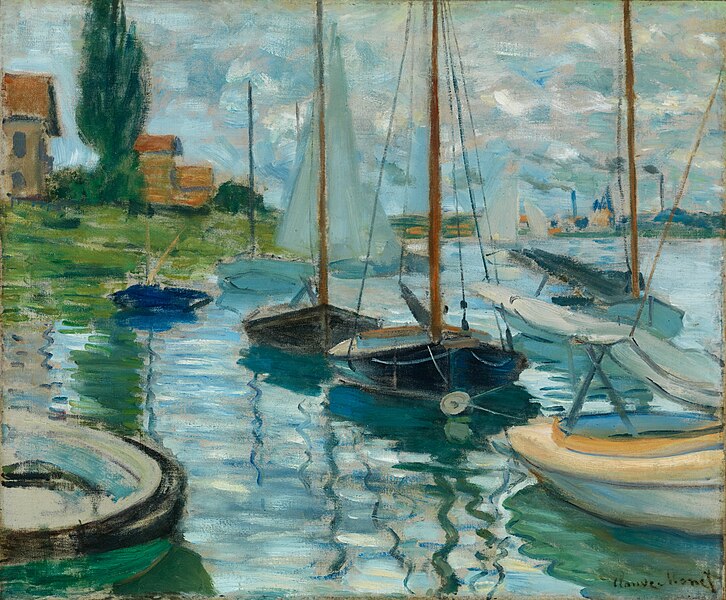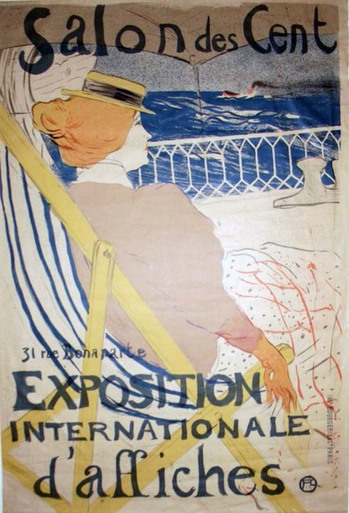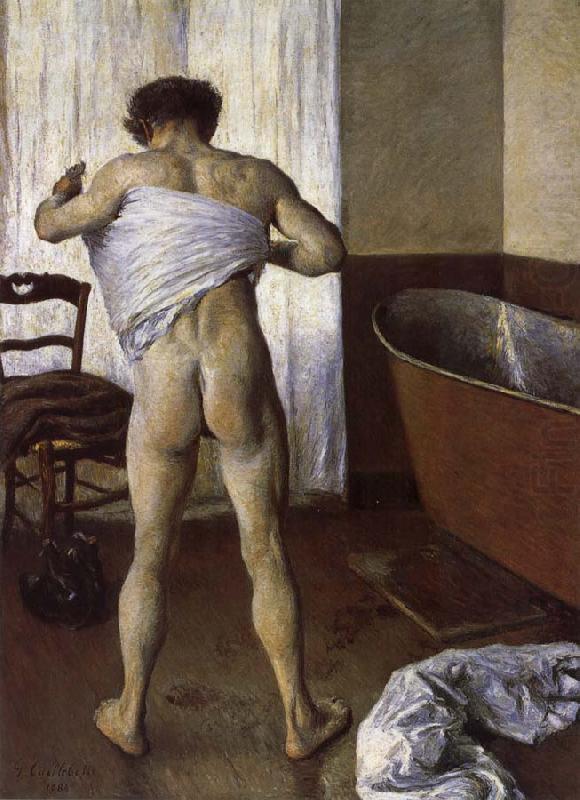The Peabody Essex Museum (PEM) opens an exhibition that demonstrates why Impressionism continues to fascinate and intrigue over a century later. With more than 90 paintings, prints, models and photographs, Impressionists on the Water tells the story of how living near France's waterways and oceans influenced one of the world's most enduring artistic movements. The sparkle and play of light on water proved irresistible to key Impressionists. Rippling seas, dancing reflections and sailboats propelled by strong winds animate the art of Manet, Monet, Renoir, Caillebotte, Pissarro, Sisley, Seurat, Signac and many others on view at PEM from November 9, 2013 to February 17, 2014.
Through this exhibition, we gain an appreciation for the inherent sensitivity that Impressionist artists showed for both the qualities of water and the appearance of the boats. Not weighed down by history, they painted what they saw and articulated it as a wholly modern subject. The juxtaposition of paintings and models allow us to observe how the artists interpreted forms of specific boats, as well as appreciate how that interpretation varied from more traditional maritime art of the day.
Examination of the Impressionists’ engagement with boating as both pastime and artistic subject is at the heart of the exhibition. In the countryside west of Paris new patterns of life, including the idea of middle-class leisure, reflected the social and economic energies of an emerging modern world. Artistic innovations such as painting out of doors developed to capture the spirit and quick pace of recreational activities. The Impressionists’ brushwork suggests both the atmospheric effects and the sensations of movement that contribute to the invigorating experience of boating.
Artists and sailors
The faithful representation of watercraft - apparent despite the freehandedness of technique - owes much to the artists' accomplishments as sailors and yachtsmen spending many hours at sea, on riverboats, leisure craft and floating studios.
Among the most skilled was Gustave Caillebotte. A sailor, boat designer and successful racer, he depicted the watercraft and nautical conditions he experienced at his family's estate on the banks of the Seine. Caillebotte is considered France's most successful yachtsman-artist of the 19th century, responsible for the design and creation of nearly 25 boats. He depicted his boating prowess in his 1893 work, Regatta at Argenteuil - himself at the helm, striking a nonchalant pose as he steers the sailboat's tiller with remarkable ease, using just a fingertip.
Inspired by the example of Charles-François Daubigny's floating studio, Monet built his own studio boat in the mid-1870s to be ever closer to the water. The vessel, depicted at its mooring in his 1874 painting, gave the artist a near-waterline perspective of the landscape, and the atmospheric conditions of the river environment. That singular perspective - a framing of light, water and sky - is celebrated throughout this exhibition.
CATALOG

An unprecedented new book celebrating the Impressionist themes of water and boats including works by the movement’s most renowned artists, such as Manet and Monet, Renoir and Seurat. Plein-air painting allowed the Impressionists to capture a vibrant outdoor world with startling immediacy; and water, boats, and all things nautical provided natural fodder for these artists, many of whom were sailors and yachtsman themselves. This unprecedented new volume, coinciding with a major exhibition organized by the Fine Arts Museums of San Francisco, traces the history of these delightful, light-infused water scenes within the social context of the latter nineteenth century. A new and expansive exploration of Impressionist themes of water and boating, this catalogue examines the changing depictions of water from pre-Impressionism (Corot, Daubigny) through Impressionism (Manet, Monet, Pissarro, Renoir, Caillebotte) to neo- and post-Impressionism (Cézanne, Seurat, Signac). Throughout, connections to contemporary life, such as the literature of Zola and Maupassant and the growing use of boats as leisure craft at yacht clubs and locales such as the famously depicted Argenteuil, clarify the social and cultural implications of the nautical themes embraced by the Impressionists. This handsomely designed book will be a welcome addition to the libraries of water-farers everywhere and will appeal to scholars and connoisseurs of one of the most beloved periods of art history.
CURATORIAL CREDIT
Organizing co-curators for Impressionists on the Water are Christopher Lloyd, former Surveyor of Queen Elizabeth II's collection; Phillip Dennis Cate, former director of the Jane Voorhees Zimmerli Art Museum at Rutgers University; and Daniel Charles, author and historian of marine technology. Daniel Finamore, PEM's Russell W. Knight Curator of Maritime Art and History, is coordinating curator.
EXHIBITION CREDITS
Impressionists on the Water is organized by the Fine Arts Museums of San Francisco.
Paintings on loan from prestigious international collections, including the Musée d’Orsay, Paris; the Van Gogh Museum, Amsterdam; the J. Paul Getty Museum, Los Angeles; and private collections will be joined by paintings and works on paper from the Fine Arts Museums’ own holdings.
The exhibition will move to San Francsco June 1–October 13, 2013 at The Fine Arts Museums of San Francisco, coinciding with San Francisco's hosting of the America's Cup races this summer.
From a great review (images added):
The show has sections dedicated to “Harbors and Coasts,” to “Rivers — Paris and Environs,” and “Open Ocean.” Amid an abundance of prints by the likes of Signac and Eugene Delatre, and a smattering of photographs by Gustave le Gray, there are standout paintings by
Ludovic-Napoleon Lepic (“Boats on the Beach at Berck”),
Alfred Sisley (“Banks of the Loing”),

(Charles-Francois)Daubigny (“The Village of Gloton”) and
Renoir (the marvelous “Oarsmen at Chatou”)(below).
But the real reason you would be mad to miss this show — its ace in the hole — is the gallery dedicated to the paintings and boat designs of Gustave Caillebotte.
There are three points to make about Caillebotte. The first is that he was a marvelous, long underrated painter. He could be plodding at times, and he was certainly not as devoted to Impressionist flux as the likes of Monet and Sisley. His pictures, although bright and light-loving, are heavily worked and fastidiously composed. But he painted many masterpieces, including
the Musee d’Orsay’s “The Floorscrapers” and
the Art Institute of Chicago’s “Paris Street, Rainy Day.”
Two years ago, recognizing Caillebotte’s quality (and the scarcity of available works by him), the Museum of Fine Arts sold works from its collection by Monet, Renoir, Pissarro, Sisley, and Gauguin, to buy a single Caillebotte:
“A Man at His Bath.”
In this show,
“Skiffs on the Yerres,” and
“Regatta at Argenteuil” (below) are almost — but not quite — in the same category.
The second point about Caillebotte is that he was respected and well-loved by his Impressionist confreres. He was the glue that kept the group together.
Born into wealth, he bought paintings by his comrades, he convened gatherings at his house, and he organized several of the later Impressionist exhibitions, renting the galleries, designing the catalogs, and financing the advertising. When he died, he gave a great slab of his superb collection to the French state.
The final thing about Caillebotte, and the most germane in the context of this show, is that he was mad about yachting.
From another good review:
Boating was a favored pastime for these artists as well as a great subject for many of them. Sailboats, racing scenes, and various ocean and water scenes appear, representing Brittany, along the western coast of France, and such vacation spots as Argenteille, along the Seine about 30 minutes from Paris. The exhibition does a wonderful job of displaying the progressive Impressionists and Post-Impressionists' aim of capturing color and light, as well as portraying these middle-class pastimes and everyday moments -- la vie quotidienne -- that they are so well known for.
Johan Barthold Jongkind, “Honfleur,” 1864, watercolor on paper, 6 3/4 x 8 1/4 in. Collection of Zimmerli Art Museum, Rutgers University
Gustave Caillebotte, "Boating on the Yerres (Perissoires sur l'Yerres)," 1877, oil on canvas, 40 3/4 x 61 3/8 in. Milwaukee Art Museum
For example, in the work "Périssoires sur l'Yerres" (1877), by Gustave Caillebotte (1848-1894), we focus on the main subjects of the men in boats, with bright highlights on the backs of their hats, but we can't ignore the brilliant reflections on the water. These reflections were a fascination for the artists, always moving, invigorating, and lively, almost dancing on the surface with lights and darks, sun and shadow. The gestural use of these lights and darks in this work, with horizontal, slightly thicker brushstrokes next to one another on the water, are an example of the radical new brushstrokes in works from this time. The areas of high contrast where the bright yellow light meets the darker greens of the reflection of the trees in the water bring our eyes to another area of interest in the work and show a mastery and deep understanding of waterscapes. Indeed, the paintings can be enjoyed for their obvious subjects as well as for their use and portrayal of light.
More images from the exhibition:

Gustave Caillebotte, Regatta at Argenteuil, 1893. Oil on canvas. Private collection. Photograph © Comité Caillebotte, Paris

Claude Monet, Boats Moored at Le Petit-Gennevilliers (Barques au repos, au Petit-Gennevilliers) (traditionally Sailboats on the Seine, 1874. Oil on canvas. Fine Arts Museums of San Francisco. Gift of Bruno and Sadie Adriani, 1962.23

Pierre-Auguste Renoir, Oarsmen at Chatou (Les Canotier à Chatou, 1879. Oil on canvas. National Gallery of Art, Washington, DC. Gift of Sam A. Lewisohn, 1951.5.2

Claude Monet, The Seine at Argenteuil (La Seine á Argenteuil, 1874. Private Collection

Henri de Toulouse-Lautrec, The Passenger from Cabin 54—On a Cruise (La passagère du 54—Promenade en yacht, 1896. Color lithograph poster with brush, crayon, and spatter. Fine Arts Museums of San Francisco. Achenbach Foundation for Graphic Arts, Bruno and Sadie Adriani Collection

Camille Pissarro, Harbor at Dieppe (Le port de Dieppe, 1902. Oil on canvas. Fine Arts Museums of San Francisco, Mildred Anna Williams Collection, 1940.52

Gustave Caillebotte, Sunflowers along the Seine (Soleils, au Bord de la Seine, about 1885 -1886. Oil on canvas. Private Collection

Claude Monet, , The Coast of Normandy Viewed from Sainte-Adresse (La côte de Normandie vue de Sainte-Adresse), ca. 1864. Black chalk on off-white laid paper. Fine Arts Museums of San Francisco. Memorial gift from Dr. T. Edward and Tullah Hanley, Bradford, Pennsylvania, 69.30.141

Paul Signac, Saint-Tropez, the Red Buoy







